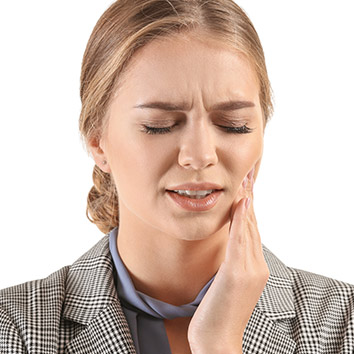Temporomandibular Disorder
Millions of Americans suffer from chronic facial and neck pain as well as severe, recurring headaches. In some cases, this pain is due to Temporomandibular Disorder (TMD) also known as Myofascial-Pain-Dysfunction Syndrome (MPD).
Your temporomandibular joints, or TMJs, connect your lower jaw to your skull. These joints get a lot of use throughout the day as you speak, chew, swallow, and yawn. Significant over-use results when you grind or clench. Especially all night, becase the forces are ten times greater. You reach tipping points: Sore jaw joints and chewing muscles, clicking, popping or grinding sounds in the joints, limited opening, locking open or closed, receeding gums on the back teeth, and extreme tooth wear. This pain is exhausting and unpleasant. Principal causes of TMJ/MPD are stress, injury, and maloccluson. However, there are hundreds of other medical conditions that cause head pain that must be ruled out by your dentist, physician, neurologist, a stress specialist, physical therapist, and chiropractor. Succesful treatment requires the combined efforts of the patient, orthodontist and several specialists working together.
Symptoms of TMD include:
- Pain in the jaw area
- Pain, ringing, or stuffiness in the ears
- Frequent headaches or neck aches
- Clicking or popping sound when the jaw moves
- Muscle spasms in the jaw area
- A change in the alignment of top and bottom teeth
- Locked jaw or limited opening of the mouth
If you notice that you are experiencing any of these symptoms, let us know at your next appointment. Dr. Neely can determine if you have TMD and create a customized treatment plan to relieve your symptoms.
Not all jaw pain is associated with TMD
If you believe you might have TMD, it is wise to see your dentist and receive an exam. However, not all jaw pain is associated with TMD, and if you do not have TMD, there are many different preventive steps you can take to maintain a healthy, strong smile.
- Always relax your face: “Lips together, teeth apart.” Understand that your teeth should not be touching unless you are chewing food and swallowing - about 20 minutes a day.
- Avoid clenching or grinding your teeth
- No gum ever
- Don’t cradle the phone receiver between your shoulder and head; Use a headset or hold the receiver to your ear with your hand
- Chew food evenly on both sides of your mouth
- Do not sit with your chin resting on your hand.
- Do not always sleep on one side.
- Practice good posture: Keep your head up, back straight, and shoulders squared. Get a good ergonometri work chair and adjust it
You can have TMD/MPD before, during, o rafter braces. It comes and goes. It is a life-long habit. Controlled university studies have shown no causal connection between orthtodontic treatment and TMD/MPD. If you are experiencing any of the symptoms listed above and are wondering whether you may be a candidate for TMD/MPD treatment, please contact our office for a consultation. Often simple measuresl, like bite splints or night guards can make a huge difference.






